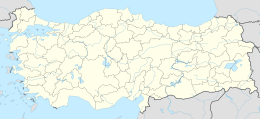Eskişehir
| Eskişehir | |
|---|---|
| Metropolitan municipality | |

Top left:Eskişehir Central railway station, Top right: Tepebaşı Municipality, Bottom left: Museum of Glassware Arts, Bottom right: Porsuk River.
|
|
| Location of Eskişehir | |
| Coordinates: 39°47′N 30°31′E / 39.783°N 30.517°E | |
| Country | Turkey |
| Region | Central Anatolia |
| Province | Eskişehir |
| Government | |
| • Mayor | Yılmaz Büyükerşen (CHP) |
| • Governor | Azmi Çelik |
| Area | |
| • Metropolitan municipality | 2,678.00 km2 (1,033.98 sq mi) |
| Elevation | 788 m (2,585 ft) |
| Population (2015) | |
| • Metropolitan municipality | 826,716 |
| • Density | 236/km2 (610/sq mi) |
| • Metro | 717,079 |
| Time zone | EET (UTC+2) |
| • Summer (DST) | EEST (UTC+3) |
| Postal code | 26 xxx |
| Area code(s) | (+90) 222 |
| Licence plate | 26 |
| Website | http://www.eskisehir-bld.gov.tr/ |
Eskişehir (pronounced [esˈciʃehiɾ]; Turkish: eski "old", şehir "city", in Greek: Dorylaeon, Δορύλαιον) is a city in northwestern Turkey and the capital of the Eskişehir Province. The urban population of the city is 717,135 with a metropolitan population of 826,135. The city is located on the banks of the Porsuk River, 792 m above sea level, where it overlooks the fertile Phrygian Valley. In the nearby hills one can find hot springs. The city is 233 km (145 mi) to the west of Ankara, 330 km (205 mi) to the southeast of Istanbul and 78 km (48 mi) to the northeast of Kütahya. Known as a university town, both Eskişehir Osmangazi University and Anadolu University (which has one of the largest student enrollments in the world) are based in Eskişehir. The province covers an area of 2,678 km2 (1,034 sq mi).
The name Eskişehir literally means Old City in Turkish; indeed, the city was founded by the Phrygians in at least 1000 BC, although it has been estimated to be older than 4000 years old. Many Phrygian artifacts and sculptures can still be found in the city's archeological museum. There is also a museum of meerschaum stone, whose production remains still notable, used to make high quality meerschaum pipes. In the fourth century AD the city moved about ten km northeast, from Karacahisar to Şehirhöyük.
Many ancient geographers described the city as one of the most beautiful in Anatolia.
...
Wikipedia

